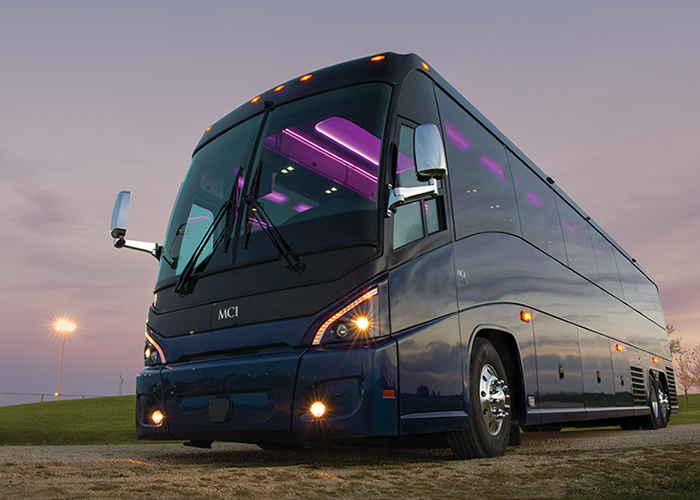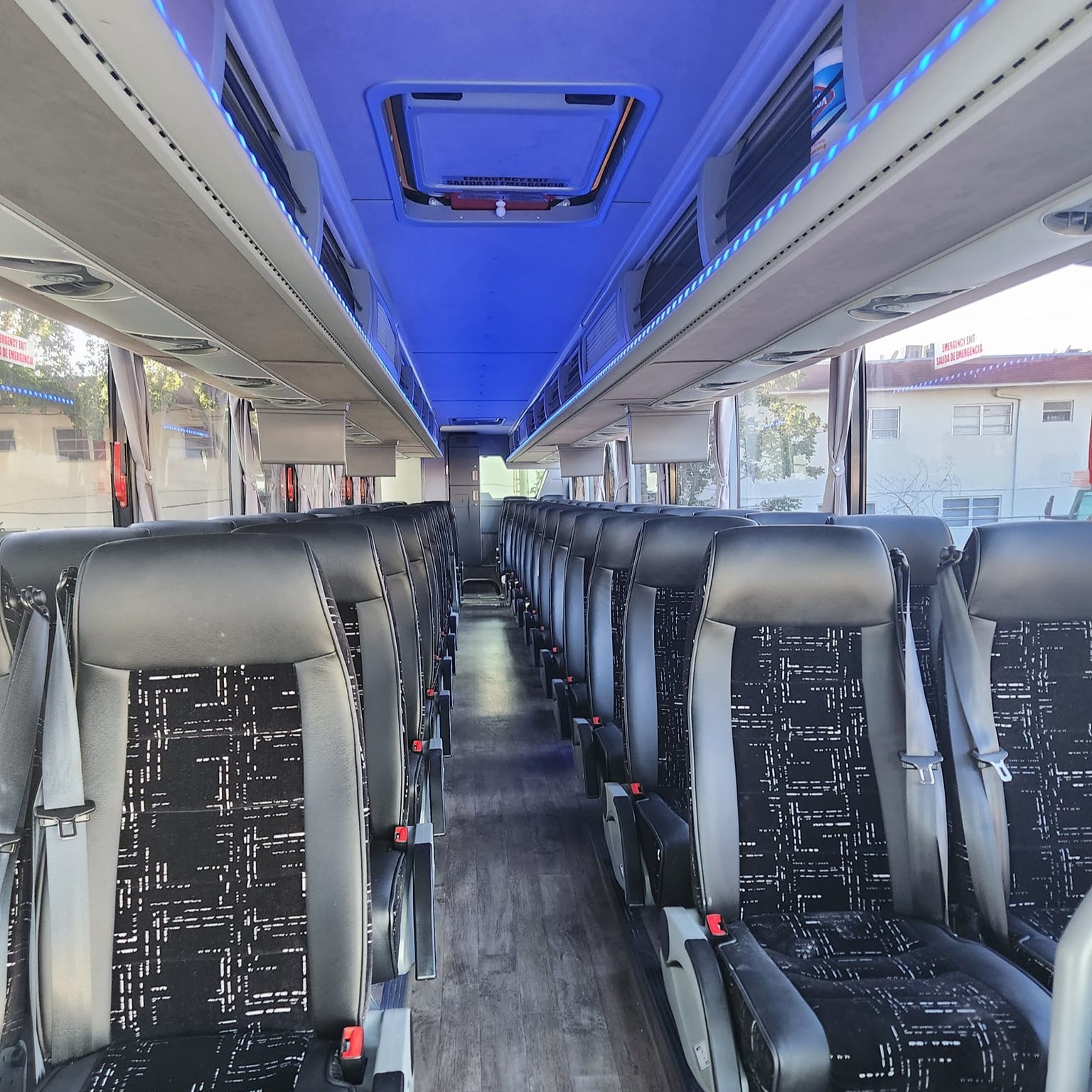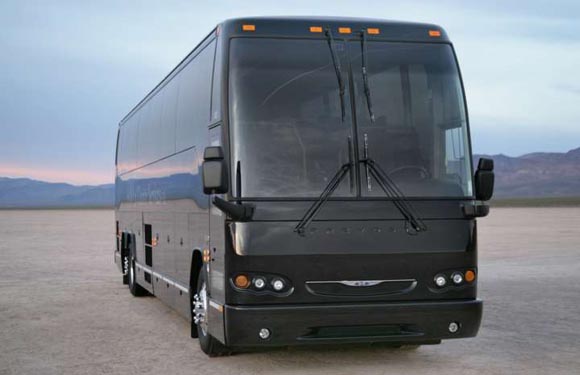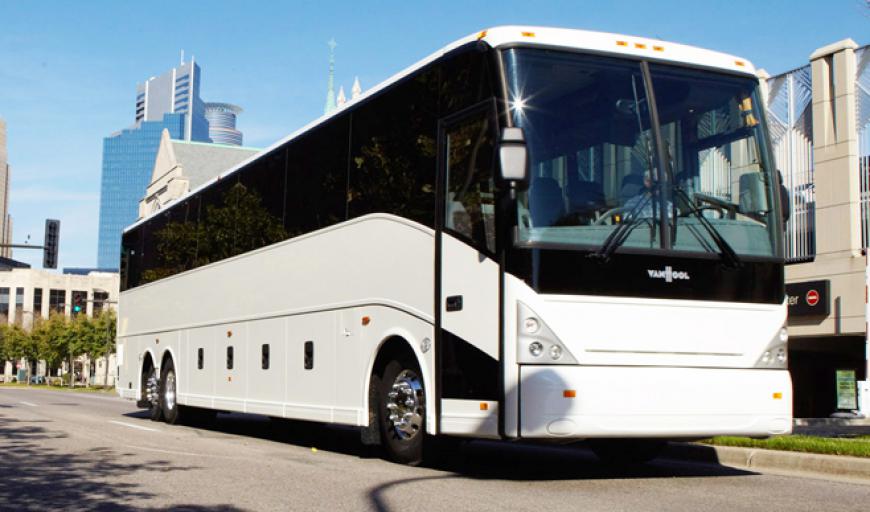When you're planning a group trip, you'll need a reliable way to transport everyone. And a charter bus is a great option! But before you call a rental company, you may want to learn more about the different kinds of buses that exist.
To help you out, we've put together this guide to four popular charter bus manufacturers. Keep reading to discover each company's history, the kinds of buses they make, and some examples of their most iconic models.
Quick Answer: Most Popular Charter Bus Manufacturers
- Motor Coach Industries (MCI)
- Temsa
- Prevost
- Van Hool
Motor Coach Industries (MCI)

Motor Coach Industries (MCI) is based in the U.S. and Canada and is one of the oldest charter bus companies in North America. Since their first bus hit the road in 1933, MCI has focused on producing buses that are safe, reliable, and comfortable.
Today, they build buses for public and private transportation, and their J4500 is America's best-selling touring coach. Want to learn more? Keep reading to discover the highlights of MCI's nearly 90-year history and the buses they produce.
History of MCI
MCI's story begins with a small repair shop in Canada and has transformed into a multinational bus manufacturer that provides reliable, comfortable coaches for both public and private transportation. Through the decades, MCI has maintained a reputation for producing some of the best buses on the road. Read on for highlights of the company's extensive timeline!
The origins of MCI date back to 1933 when Harry Zoltok, a mechanic and repair shop owner, sketched out a new design for an 11-passenger vehicle. Zoltok's shop, called Fort Garry Motor Body and Paint Works, soon became ground zero for pioneering motorcoach designs and production.
In 1944, following a brief period of manufacturing military vehicles during World War II, the company rebranded as Motor Coach Industries and focused entirely on bus manufacturing. MCI's first rear-engine coach model, the Model 100, launched in 1945 as passenger transportation bounced back from the war era.
Throughout the 1950s, MCI continued innovating with new models equipped with heating systems and improved interiors. The MC-9, introduced in 1959, would go on to become MCI's best-selling bus of all time in Canada.
The 1960s brought expansion into the United States with the opening of a manufacturing plant in Pembina, North Dakota. International recognition came in 1967 when Greyhound commissioned MCI's sleek "MC-6 Super Cruiser" coaches. By 1968, MCI was producing 500 buses annually.
Subsequent decades saw MCI setting new standards for motorcoach accessibility, developing some of the first wheelchair lifts and models with mobility accommodations in the 1980s and 90s. The Renaissance and J4500 models launched in 1997 and 2001 ushered in a new era of luxury touring coaches. Today, MCI remains focused on innovation with upcoming all-electric coach models planned for widespread availability.
MCI’s Fleet
MCI's product lineup covers a wide range of transit and private motorcoaches organized into two main series - the J-Series and D-Series coaches. Here's an overview of some of their most popular models:
J4500 - Dubbed "America's best-selling touring coach," the J4500 provides a premium experience for up to 60 passengers. Key features include a customizable entryway light that projects logos, LED lighting, and MCI's signature Smartwave Titanium suspension system for an ultra-smooth ride.
J3500 - A slightly smaller counterpart to the J4500, this model has the largest seating capacity of any 35-foot coach at 44 passengers. The J3500 also boasts an efficiency-boosting e-FAN system and plenty of luggage space.
D4505 - Part of MCI's reliable and affordable D-Series coaches, the D4505 is a former best-seller known for its durability and performance for up to 55 passengers. This 45-foot model is no longer in production but can still occasionally be found in some fleet rotations.
Upcoming J4500 and D45 CRTe LE - MCI plans to soon release their latest all-electric coach models aimed at the private bus market. The J4500e is a high-capacity electric coach with an expected range of up to 350 miles, while the lower-floor D45 CRTe LE will feature mobility device accommodations.
MCI Bus Specs
| Model | Weight | Height | Width | Length | Seats | Luggage Capacity | Fuel Tank |
|---|---|---|---|---|---|---|---|
| D45 CRT LE | 54,000 lbs | 138 in | 102 in | 45.58 ft | 54 | 135 cu ft | 183 gal |
| D4000 Commuter | 46,000 lbs | 137 in | 102 in | 40.50 ft | 49 | - | 164 gal |
| D4505 | 50,000 lbs | 137 in | 102 in | 45.42 ft | 55 | 517 cu ft | 164 gal |
| J4500 | 54,000 lbs | 141 in | 102 in | 45 ft | Up to 60 | 573 cu ft | 183 gal |
| J3500 | 42,000 lbs | 141 in | - | 35 ft | Up to 44 | 285 cu ft | 164 gal |
Temsa

Headquartered in Turkey, Temsa manufactures coaches, city buses, light trucks, and minibuses. With more than 50 years of experience, Temsa has built a reputation for high-quality buses in 66 countries. They’re also committed to sustainability, and they're currently developing electric and hybrid buses.
Temsa made their U.S. debut in 2008 and have quickly become a popular contender for American bus operators. In 2017, more than 1,000 Temsa buses hit the road in the U.S.
History of Temsa
Temsa's story begins with the company's founding by the Sabanci family business group in 1968. Originally established as a steel construction supplier, Temsa ventured into vehicle manufacturing in 1984 through a licensing agreement with Mitsubishi to produce light trucks.
Coach bus production commenced in 1987 with the debut of the Maraton model. The Maraton quickly gained popularity across Turkey and served as a launching point for Temsa's independent bus design and engineering capabilities.
By the turn of the century, Temsa was exporting vehicles to over 66 countries. The company released their first proprietary coach design, the Safari, in 2001. Subsequent years brought an expanded focus on developing eco-friendly buses along with city transit models like the Avenue and electriCity lines.
Temsa's growth accelerated rapidly in the late 2000s as the company expanded its distribution across Western Europe and made inroads into the massive North American bus market. In 2008, Temsa partnered with U.S.-based Ch Bus Sales to introduce the TS35 model to tour and charter operators, providing a reliable and affordable Turkish-built alternative to dominant American brands.
The 2010s were a tumultuous period as Temsa navigated ownership changes and financial difficulties. However, the company emerged stronger through joint partnerships, including Sabanci Holdings acquiring a 50% stake alongside Czech company Skoda Transportation in 2020.
Today, Temsa continues increasing its North American market share while developing new electric and alternative fuel models to meet evolving emissions standards.
Temsa’s Fleet
While Temsa offers a diverse lineup of motorcoaches across global markets, their roster of touring coaches currently available in the United States is fairly concise:
TS 30 - This compact 30-foot model is Temsa's smallest coach offering in North America. Despite its compact size, the TS 30 can accommodate up to 34 passengers along with generous luggage capacity. The fully stainless steel body construction provides an affordable blend of maneuverability and durability.
TS 35 - As Temsa's first model introduced for the U.S. market back in 2008, the TS 35 quickly gained a following among cost-conscious tour companies. This 35-foot coach seats up to 40 passengers and offers ample luggage storage along with reclining seats and entertainment systems.
TS 45 - The flagship of Temsa's American lineup, the TS 45 is a full-sized 45-foot motorcoach built to compete with models from industry giants like Prevost and Setra. With a capacity of up to 56 passengers, this bus aims to balance interior space and amenities with operational costs.
TS 45E - Initially slated for a 2020 release before delays, the TS 45E is Temsa's first all-electric touring coach planned for the North American market. This zero-emissions TS 45 variant could be a potential gamechanger by offering pro-level luxury with environmentally friendly electric propulsion.
In addition to these touring coaches, Temsa manufactures numerous city transit buses and smaller shuttle models for public agencies and private transportation providers. However, their core motorcoach lineup remains focused on the TS 30, TS 35, and TS 45 models.
Bus Specs
| Model | Weight | Height | Width | Length | Seats | Luggage Capacity | Fuel Tank |
|---|---|---|---|---|---|---|---|
| TS 30 | 27,980 lbs | 11 ft | 7.9 ft | 30 ft | 34 | 190 cu ft | 80 gal |
| TS 35 | 37,448 lbs | 11.5 ft | 8.3 ft | 35 ft | 40 | 215 cu ft | 154 gal |
| TS 45 | 51,500 lbs | 11.6 ft | 120 in | 45 ft | Up to 56 | 460 cu ft. | 200 gal |
| Maraton 13 | 18,000-19,000 kg | 3.9 m | 2.5 m | 13.08 m | 57+1 | 14 cu m | 583 L |
Prevost

Founded in 1924, Prevost is a French-Canadian motorcoach manufacturer. They’re now owned by Volvo, and they’re known for producing buses that are easy and comfortable to drive. Prevost charter buses also have a reputation for luxury, with features like high ceilings and comfortable seats.
Prevost prioritizes environmentally-friendly design, and they were the first and only North American bus manufacturer to earn ISO 14001 certification for their efforts to protect the environment. Need more proof that Prevost knows how to build quality buses? They also built the frames for Ground Force One, the motorcoaches used by the U.S. president.
History of Prevost
Prevost's story dates back to 1924 when Eugene Prevost, a Canadian woodworker, was commissioned to build a wooden motorcoach body to install on a truck chassis. Prevost's quality craftsmanship quickly earned a strong reputation, leading to the establishment of his first bus manufacturing plant in Sainte-Claire, Quebec in the late 1930s.
A pivotal moment came in 1951 when the Canadian government awarded Prevost a 100-bus order, cementing the company's status as a preeminent bus builder. As Prevost continued expanding through the 1960s, they opened a New Jersey dealership, marking their first foray into the United States.
The 1980s saw Prevost lean into luxury touring coaches with the revolutionary H-Series. This flagship line's elegant design and spacious interiors solidified Prevost as a premier brand for motorcoach transportation and kicked off a period of rapid product innovation and growth.
1995 brought a new era as Prevost became part of the newly-formed Volvo Bus Corporation. This partnership granted access to Volvo's extensive resources and technologies, allowing Prevost to further refine their engineering. The X-Series was launched in the late 90s with a strikingly modern look and improved efficiency.
In the 2000s, Prevost doubled down on green initiatives by collaborating with Volvo to develop hybrid and clean diesel propulsion systems for public transit applications. On the touring coach side, Prevost heavily updated the H-Series with sleek new styling in 2009.
Today, Prevost continues pioneering advanced safety systems and investing in sustainable mobility solutions for private and public transportation under Volvo's leadership. The company maintains production facilities across Canada and the United States.
Prevost’s Fleet
Whether you need a spacious touring coach or an efficient commuter shuttle, Prevost likely has a model tailored to your needs:
H3-45 - The H-Series is the flagship of Prevost's lineup and the H3-45 sits at the top of the range. This 45-foot luxury touring coach provides a premium experience with panoramic windows, LED lighting, advanced ergonomics, and the largest undercarriage luggage capacity of any Prevost model.
X3-45 - The X3-45 prioritizes visibility, efficiency, and versatility in its modern design. A recent redesign improved aerodynamics for up to 10% greater fuel efficiency compared to prior models. The X3-45 is also available in an accessibility-focused Commuter version with easy entry and workspace accommodations.
Volvo 9700 - As part of their partnership, Prevost distributes this popular intercity motorcoach manufactured by Volvo. The 9700 stands out for its modular customization with flexible interiors that can be tailored for any transit application. Hybrid and electric propulsion versions are available.
In addition to these flagship models, Prevost oversees production of smaller shuttle buses, public transit vehicles, and specialty equipment through its strategic partnerships and manufacturing facilities across North America.
One of Prevost's key strengths is their ability to incorporate advanced technologies and top-tier amenities across their entire product portfolio. You'll find cutting-edge features like self-leveling air suspension, real-time diagnostic systems, optimized climate controls, and chic interior stylings even on smaller commuter coaches and transit buses wearing the Prevost badge of quality.
Prevost Bus Specs
| Model | Weight | Height | Width | Length | Seats | Luggage Capacity |
|---|---|---|---|---|---|---|
| H3-45 | 50,700-54,000 lbs | 12 ft 3 in | 8.4 ft | 45 ft | 48-56 | 470 cu ft |
| X3-45 | 35,920 lbs | 11 ft 1 in | 8.45 ft | 45 ft | 57 | 350 cu ft |
| Volvo 9700 | 49,400 lbs | 12 ft | 8.5 ft | 45 ft | 54 | 400 cu ft |
Some key additional specs:
H3-45
- 470 cu ft undercarriage luggage capacity
- 58-109 cu ft parcel rack luggage capacity
- Weight ranges from 50,700 lbs to 54,000 lbs depending on configuration
X3-45 Commuter
- Lower entry height at 80 inches
- Wider entry door and aisle space
- Power outlets and reading lamps at each seat
Volvo 9700
- Available in diesel, electric, and hybrid versions
- Customizable interiors with various seating options
- Modern cockpit with ergonomic driver's area and digital instrumentation
Van Hool

Founded in 1947, Van Hool is a family-owned commercial vehicle and motorcoach manufacturer based in Belgium. Though they produce more industrial vehicles than buses, the company is known for its world-renowned coaches. They export 80% of their vehicles, and they have a strong reputation in North America.
Van Hool buses feature comfortable interiors with high-end touches and extra-tall front windows for optimal driver and passenger visibility.
History of Van Hool
The roots of Van Hool can be traced back to the years immediately following World War I. In 1928, Bernard Van Hool founded a small construction company focused on rebuilding roads and bridges decimated by the conflict. To transport workers to and from job sites, Van Hool converted an old bus from a military vehicle into a makeshift personnel carrier.
Van Hool's ingenuity and craftsmanship with this repurposed bus inspired the company to venture into vehicle manufacturing. By 1948, they had released their first production motorcoaches, beginning with the fittingly named "De Trekvogel" (The Migratory Bird). These early models drew inspiration from American designs with tailfins, chrome accents, and sweeping contours.
The 1950s marked Van Hool's entrance into international markets as their vehicles gained widespread acclaim. A key partnership with Fiat in 1957 allowed Van Hool to incorporate the Italian company's engines and components into new coach designs for broader European distribution.
While Van Hool's truck and trailer production expanded through the 60s, their motorcoaches remained a core focus. The iconic Acron touring coach, launched in 1979, was an immediate success and cemented the company's status as a premier bus manufacturer.
The 1980s brought computer-aided design and manufacturing capabilities that allowed Van Hool to develop lighter, more aerodynamic buses tailored for public transit applications. This versatility opened doors for further global expansion into the 1990s.
A pivotal milestone was achieved in 1987 when Van Hool secured distribution across North America through an agreement with Tennessee-based ABC Companies. This partnership introduced the TX and CX series coaches that remain popular options in the United States and Canada today.
Van Hool’s Fleet
While Van Hool maintains separate product lines for markets in Europe and North America, their core touring coach offerings for U.S. operators include:
CX Series - Marketed as mid-level touring coaches, the CX lineup aims to balance economical pricing with modern styling and amenities. The CX45 is a popular model configurable for up to 56 passengers with ample luggage capacity. An all-electric CX45E variant is also in development.
TX Series - Representing the premium luxury category, TX coaches like the TX45 and TX40 prioritize first-class accommodations and cutting-edge features. Highlights include tinted panoramic windshields, sleek LED lighting, and optional amenities like embedded charging ports at each seat.
TDX25 - Van Hool's double-decker touring coach sets itself apart with a massive 81-passenger capacity across two levels. The TDX25 brings dual-level luxury travel to North America while maintaining excellent maneuverability for urban routes.
Beyond these touring coaches for private charter companies and transit agencies, Van Hool produces a diverse range of smaller shuttle buses, public transit vehicles, and specialty coaches tailored for specific applications.
Van Hool's reputation is built on seamlessly blending modern European styling and high-tech components with rugged North American-caliber engineering. Customers can expect meticulous attention to detail in the build quality and materials along with low interior noise and vibration across Van Hool's vehicle lineup.
Each model also offers Van Hool's signature fiberglass-reinforced polymer (FRP) body construction. This lightweight yet durable monocoque design contributes to superior fuel economy while enabling sleeker aerodynamic designs compared to traditional framed construction methods.
Van Hool Bus Specs
| Model | Weight | Height | Width | Length | Seats | Luggage Capacity |
|---|---|---|---|---|---|---|
| CX45 | 50,700-54,000 lbs | 12 ft 3 in | 8.4 ft | 45 ft | 48-56 | 384-440 cu ft |
| TX45 Acron | 50,700-54,000 lbs | 12 ft 3 in | 8.4 ft | 40-45 ft | 48-56 | 384-440 cu ft |
| TDX25 | - | 13.12 ft | 8.3 | 43.14 ft | 81 | 247 cu ft |
Key Additional Specs:
CX45
- 58-109 cu ft parcel rack luggage capacity
- Multiplex electrical system
- Optional 3-point seatbelts
- FRP monocoque body construction
TX45 Acron
- Same core dimensions as CX45
- Higher customization for luxury interiors
- Patented rear bedroom option up to 40 ft lengths
- Available galley and lavatory options
TDX25
- Height of 13 ft 6 in
- Single and double deck floor plans available
- Low center of gravity and tight turning radius
- Separate luggage rooms on lower level
Book a Charter Bus with Price4Limo
So in summary, this comprehensive guide has provided an in-depth look at four major charter bus manufacturers in the United States - MCI, Temsa, Prevost, and Van Hool. Each company brings a unique expertise, product lineup, and heritage to the motorcoach industry.
No matter which bus manufacturer you’re interested in, Price4Limo can connect you with a charter bus rental that fits your group’s needs. We have access to a wide network of charter buses and minibuses in over 1,000 US cities. Our team is also here to help you find the right rental at the best rate. We’re one of America’s most trusted bus rental companies with over 1,000,000 passengers served and over 2,500 five star reviews. Give us a call at 1-866-265-5479 today, and we’ll get you a personalized quote.